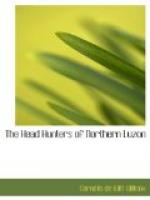The mists prevented any general view of the country; as a matter of fact, we were at such an elevation as to be riding in the clouds, which had come down by reason of the rain. However, the valleys below us were occasionally in plain enough sight, showing some cultivation here and there, rice and camotes, the latter occasionally in queer spiral beds. The bird-scarers, too, were ingenious: a board hung by a cord from another cord stretched between two long and highly flexible bamboos on opposite banks of a stream, would be carried down by the current until the tension of its cord became greater than the thrust of the stream, when it would fly back and thus cause the bamboo poles to shake. This motion was repeated without end, and communicated by other cords suitably attached to other bamboo poles set here and there in the adjacent rice-paddy. From these hung rough representations of birds, and a system was thus provided in a state of continious agitation over the area, frequently of many acres, to be protected. The idea is simple and efficacious.
This long stretch terminated in a land-slide leading down into the dry, rocky bed of a mountain stream. At the head of the slide we turned our mounts loose, and all got down as best we could, except Mr. Forbes, who rode down in state on his cow-pony. Once over, we crossed a village along the edge of a rice-terrace, in which our horses sank almost up to their knees. As the wall was fully fifteen feet high, a fall here into the paddy below would have been most serious; it would have been almost impossible to get one’s horse out. However, all things come to an end; we crossed the stream below by a bridge, one at a time (for the bridge was uncertain), and found ourselves in Talubin, where we were warmly greeted by Bishop Carroll of Vigan and some of his priests. The Bishop, who was making the rounds of his diocese, had only a few days before fallen off the very trail we had just come over, and rolled down, pony and all, nearly two hundred feet, a lucky bush catching him before he had gone the remaining fourteen hundred or fifteen hundred.
Talubin somehow bears a poor reputation; its inhabitants have a villainous look, owing, no doubt, in part to their being as black and dirty as coal-heavers. This in turn is due to the habit of sleeping in closed huts without a single exit for the smoke of the fire these people invariably make at night, their cook-fire probably, for they cook in their huts. However this may be, the people of this rancheria showed neither pleasure nor curiosity on seeing us, and I noticed that a Constabulary guard was present, patrolling up and down, as it were, with bayonets fixed and never taking their eyes off the natives that appeared. These Igorots lacked the cheerfulness and openness of our recent friends, the Ifugaos. Their houses were not so good, built on the ground itself, and soot-black inside. The whole village was dirty and gloomy and depressing, and yet it stands on the




